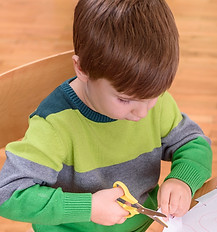top of page

Scissors Skills Milestones

Children develop scissors skills over several years. Progress depends on a child's skills in several areas including visual perceptual and visual motor skills, hand strength and development, bilateral two-handed coordination, attention, as well as trunk strength and shoulder stability. Children must learn how to hold the scissors safely and efficiently. They need to master the ability to cut while they simultaneously hold and turn the page with the helping hand.

Scissors Skills Milestones
Why Are Scissors Skills Imp?
Why Are Scissors Skills Important?

There are several benefits to helping a child master scissors skills. These include but are not limited to the following:
* Improve fine motor skills and hand strength
* Improve visual perception and visual motor skills
* Cutting activities and crafts open the gateway to creativity
* Scissors skills will be required in the classroom for years to come
* Scissors skills are the foundation for more complex hand skills
Choosing Scissors
Choosing Scissors

When choosing appropriate scissors for a child, consider several scissors characteristics. First, scissors must fit a small hand and should be comfortable and safe for a child to manipulate. Blades may be plastic (as with play-doh scissors) or metal. Plastic blades may be safer for younger children. The scissors may be spring-action or regular. Spring-action scissors automatically open for kids. These may be easier for children who are less experienced at cutting.
Initial Cutting Strokes
Initial Cutting Strokes

Introducing appropriate cutting activities to children is crucial. Choosing a task that is too hard will prove frustrating to kids. When children master simple tasks first, they develop their confidence, their skills, and most importantly, their enjoyment of scissors use. Initial cutting strokes should include cutting play-doh (roll play-doh into snakes then cut the snakes in to pieces), snipping strips of paper, making fringe on paper. Repetition of these initial steps are vital for children.
Later Cutting Strokes
Later Cutting Strokes

Later cutting strokes include cutting straight lines, curves, circles and spirals. Ensure that children have plenty of practice before moving on to more complex shapes such as triangles and squares. At first, simply encourage kids to try to cut along the line - make lines wider with a marker so children have an easier time and develop confidence in their abilities. Remember that mature scissors skills take years to master. A child will not develop solid cutting skills until six to seven years or older.
Check out my Scissors Skills & Science series!
This growing bundle of (10 books, 8 activities per book) helps kids master scissors skills in a developmental sequence, all while learning science concepts!
This series includes:
And coming soon:
Book 6: Cut Curvy Lines
Book 7: Cut Spirals
Book 8: Cut Circles
Book 9: Cut Right Angles
Book 10: Cut Squares
Book 1: Cutting Playdoh
Book 2: Make Fringe
Book 3: Snipping
Book 4: Cut Straight Lines
Book 5: Cut Zig Zag Lines
Visit Kids Master Skills
at Teachers Pay Teachers!
Follow Kids Master Skills
on Social Media
bottom of page





